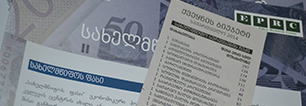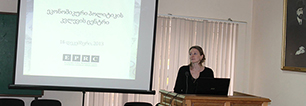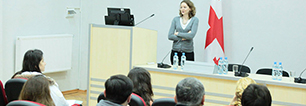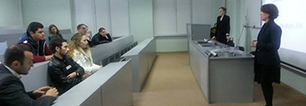
Anti-Crisis Stimulus Package for Economic Recovery
Assessment of the Government’s Financial Activity for 2013 and the First Quarter of 2014
The report has been published within the framework of the project – Anti-Crisis Stimulus Package for Economic Recovery. The project is being implemented with the support of East West Management Institute (EWMI) program - Policy, Advocacy and Civil Society Development in Georgia (G-PAC), funded through US Agency for International Development (USAID).
The overall objective of the project is to establish the culture of crisis management in Georgia and provide expert guidance to the government in creation of an anti-crisis document for economic recovery stimulus package. The aim of this paper is to analyze financial performance of the government of Georgia in 2013 and the first quarter of 2014; also, to evaluate the implemented economic policy and results thereof.
The study has shown that:
• The year 2014 began with better economic indicators as compared to the previous year. Economic growth rate in January and February was quite high – the real GDP growth comprised 8% in January, 5.4% in February, 8.3 percent in March. In 2014, as compared to the previous year, the situation also improved in terms of mobilizing budgetary tax revenues. During the past three months the budget collected 1,639.4 million GEL, which exceeds the planned indicator of 1,618.3 million GEL;
• 2014 budget is planned to grow by 8,5 percent as compared to the previous year, the planned indicator of budget revenues for the first quarter of 2014 exceeds a corresponding indicator of the previous year by 4.2% alone, whilst the actually collected amount by 5.5%; this means that the plan for the first quarter is partially reduced;
• The first quarter of 2014 saw a shortfall in grants – out of planned 51,8 million GEL only 3,2 million lari was disbursed; in other revenues some 53,1 million GEL was mobilized instead of planned 74,3 million GEL;
• The state budget allocations in 2014 stand at 9 080.0 million GEL. Out of this amount 1 840.4 million GEL was spent in the first quarter, which comprises 20% of the planned expenditure. The total spending on infrastructure projects made up 8.6% in Q1 2014, whereas corresponding indicators stood at 10.9% in 2013 and at 12.4% in 2012; It is noteworthy, that low budgetary spending for the first three quarters of 2013 was considered to be the major cause for shortfalls in the budgetary revenues and expenditures and created a pressure on the national currency in the final quarter; therefore, the data from the first quarter once again proves that this tendency and threats are maintained in 2014, and even strengthened;
• Q1 2014 saw improved macroeconomic indicators; however, this improvement is conditioned, on the one hand, by the base effect and, on the other hand, by high spending in the fourth quarter of 2013. As compared to the previous year, the budget in Q1 2014, underperformed by 77 million GEL (46 million in tax revenues and 21 million in other revenues);
• The state budget envisages some 1,6 billion GEL as a credit resource to be attracted in 2014; this indicator significantly exceeds the actual indicator in 2013 which totaled 737,9 million GEL; state debt indicator is considerably increased in 2014 as compared to 2013; • The simulation analysis showed that the 2014 budget had a higher capacity to be totally regarded as a growth oriented budget, however this means were not taken into account; The year 2013 showed the following:
• In 2013, an average economic growth comprised 3.2 percent which is lower as compared to the forecasted indicator by 2.8 percentage points; this growth rate was achieved owing to the 7.1 percent economic growth observed in the fourth quarter of 2013;
• Loans to economy issued by banking institutions showed a significant increase over the period from October to December. The indicator of loans exceeded 1 billion GEL in the fourth quarter of 2013;
• The pace of budget spending was slow in the first half of 2013. The highest spending was observed in the third and fourth quarters in terms of both total allocations and infrastructure project financing;
• Shortage in collecting tax revenues in the budget amounted to 632,3 million GEL in 2013. The largest shortfall was seen in VAT revenues with the collection rate at 83.7% against the planned target and the amount of shortfall comprising 554,6 million GEL;
• The shortfall in tax revenues did not occur only at the end of 2013. In reality, it was observed against the initially planned estimates throughout the year; quarterly plans were continuously corrected by the decrees of the Minister of Finance a few days before the end of a corresponding accounting quarter, thereby resulting in the percentage indicators of tax revenue performance exceeding 100% as compared to planned targets;
• In parallel with the shortfalls in budgetary revenues, the budgetary expenditures underperformed as well. In 2013, the actual budgetary expenditures comprised 8,1 billion GEL as compared to the planned 8,7 billion GEL;
• Out of unspent 644,3 million GEL, 162 million GEL is the sum which was not spent from investment projects allocations financed by donors;
• The largest percentage share of unspent amounts account for health care sector. Out of amounts allocated for this sector, 174 million GEL was not spent;
• In 2013, approximately 524 million GEL could have been channeled towards financing economic projects to avoid a slowdown in economic processes;



 WHAT DO YOU PAY
WHAT DO YOU PAY BUY YOUR OWN STATE
BUY YOUR OWN STATE UNIVERSE OF PUBLIC EXPENDITURES
UNIVERSE OF PUBLIC EXPENDITURES STATE WASTE
STATE WASTE










